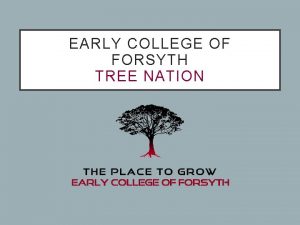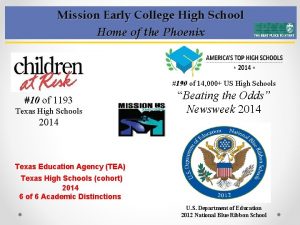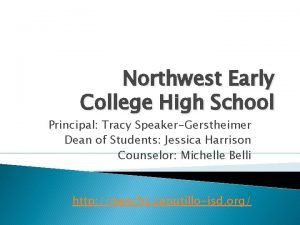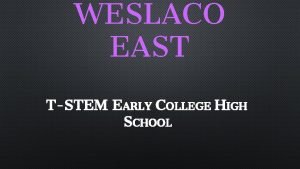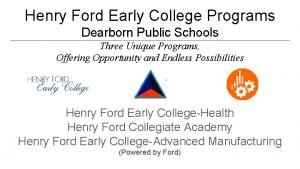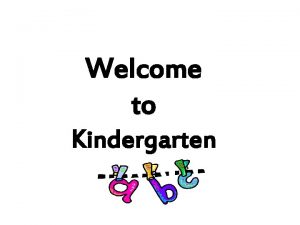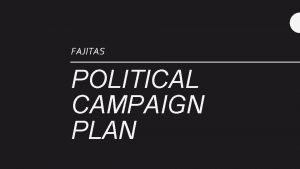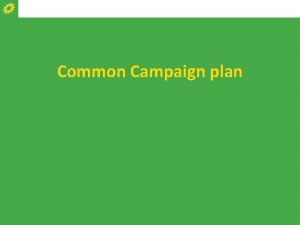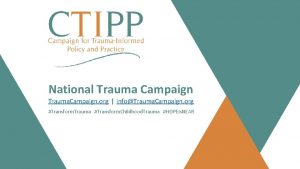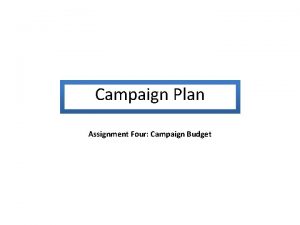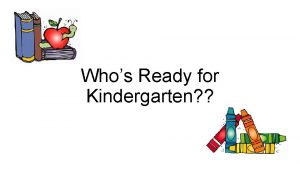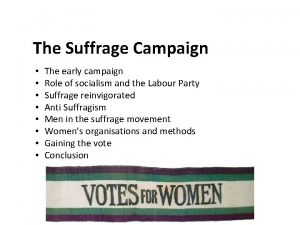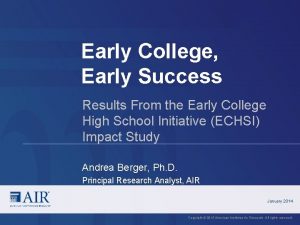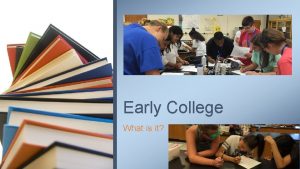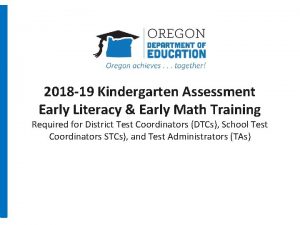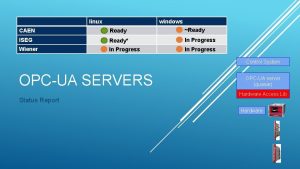Ready for Kindergarten Ready for College Campaign Early


















- Slides: 18

Ready for Kindergarten, Ready for College Campaign Early Care and Learning Legislative Briefing February 10, 2021

Thank you 2 To our co-hosts: l. Senator Shelley Mayer l. Assemblymember Kimberly Jean-Pierre

Overview: Child Care in New York State 3 $4. 3 Billion Dollar Sector 860, 000 children in paid care arrangements (Centers, Family Based, Informal, etc. ) Approximately 100, 000 children served on average each month by subsidy system (down from 135, 000 in 2011) l State supervised/locally administered system l Funded by federal, state, local government revenues plus parent fees l Counties set local eligibility policies within broad state parameters

Child Care is Unaffordable for Nearly ALL New York Families 4 Average annual cost infant in child care center: $13, 390 To be “affordable” (7% of income or less): need income of $191, 285

Child care is essential to a healthy, inclusive economy 5 Claire Ewing-Nelson. Four Times More Women Than Men Dropped Out of the Labor Force in September. National Women’s Law Center. Oct. 2020 Fact Sheet.

Small Percentage of Eligible Children Served 6 Data Sources: Developed from 1) American Community Survey data for the number of children under 6 residing in households making less than 200% of poverty threshold and all parents in workforce, 2) 60% (the share of children under 6 served by NY’s subsidy system) of the average number of children served by NY’s child care assistance programs each month from July 2019 June 2020 according to NYS’ Office of Temporary and Disability Assistance

Statewide Decline in Children Served Since 2011 7 Data Source: Office of Temporary and Disability Assistance – Statistical Report on the Operations of New York State Temporary Assistance Programs - 2011 and 2020

The pandemic has pushed the child care sector to the brink of collapse 8 New York’s child care providers – who struggle to cover costs when operating at 100% capacity – have been averaging 40% capacity since March. More than 60% are losing money each month; the same percentage report having taken on personal debt or dipped into personal savings to cover shortfalls. Without significant relief soon, many providers will be forced to close their doors. Parents were apprehensive to use child care programs, center or family based. Most who continued to be enrolled and attend, were children of essential workers or parents who needed to be working outside their home.

New York City Child Care 9 Notes: Subsidized child care includes contracted Early Learn seats and vouchers for all modalities: center-based, family child care and informal. Borough Enrollment in subsidized child Children under Care for children under 5 in households New York City boroughs below 200% FPL % of children under 5 served Bronx 19, 784 63, 023 31. 4% Brooklyn 24, 114 86, 673 27. 8% Manhattan 7, 861 23, 362 33. 7% Queens 9, 149 51, 814 17. 7% Staten Island 2, 073 7, 526 27. 6% Grand Total 62, 981 232, 398 27. 1% Children under five years old include: infants, toddlers and preschool age children (three and four-year-olds). Preschool aged children may be enrolled in programs that are part of Pre-K for All or 3 K for All. Data Source: Enrollment in Subsidized child care: New York City Administration for Children Services, March 2019. Children under 5 in households below 200% FPL: U. S. Census Bureau, American Community Survey. Public Use Microdata Sample (PUMS) file. Combined 1 -Year Estimates (2017 -2019) § All 4 -year-olds now have access to pre-K and a growing number of 3 -year-olds are now enrolled in 3 K for All. This year (SY 2019/20), nearly 87, 500 children were enrolled in full day and half day Pre-K and 3 -K For All.

New York City Child Care 10 NYC SUBSIDIZED SYSTEM BY FUNDING TYPE Early Learn 106 681 100 362 100 195 Voucher 101 952 100 000 80 000 72 287 68 397 67 428 68 271 34 394 32 934 31 924 33 555 2013 2014 2015 2016 All Subsidized 99 596 66 683 96 344 93 241 62 711 61 193 32 913 33 633 32 048 2017 2018 2019 60 000 40 000 20 000 Notes: Subsidized child care includes contracted seats (Early Learn) and vouchers for all modalities (center-based, family child care and informal) for all age groups (infants, toddlers, preschool and school-age children). Data Source: Enrollment in Subsidized child care: New York City Administration for Children Services. Data as of May for 2013 to 2017 and data as of March for 2018 and 2019.

Pre-K System – A $848 million investment but only 2/3 of children have access 11 State funded full day pre-K for 3 and 4 year olds to public schools with at least 10% reserved for community based organizations Amount of funding per student depends on the program: l UPK program: the funding is based on need and on the Foundation Aid allocation l The full day state funded, is $10, 000 per student More than half of the children (and funding) in pre-K are in community based organizations Read more HERE

Pre-K programs were hit hard by the pandemic 12 As a result of the cuts to state funding for K-12 public education, pre-K programs were in danger of being eliminated or reduced The CARES Act include $1. 1 billion for New York’s public schools. However, this impact of this money did not ever reach schools as the state cut an equivalent amount from its share of funding. Labor Region Capital District Central New York Finger Lakes Hudson Valley Long Island Mohawk Valley New York City North Country Southern Tier Western New York Percent of Four Year Olds In Full Day Pre-K 2018 -19 24% 27% 30% 19% 13% 28% 95% 29% 48% 34%

Pre-K in the 2021 -2022 Executive Budget 13 No increase in pre-K funding. The $12 million that the executive budget shows as an increase, is funding that was not used in years prior and is available to all school districts. The enacted budget must ensure that all pre-K funding remains available to school districts, even with fluctuations in enrollment.

Child Care in the 2021 -2022 Executive Budget 14 Flat funding for child care subsidies at $832 million. l The State general fund investment is $229 million, just above the minimum needed to draw down full federal Child Care Community Development Block Grant (CCDBG) funds. l $166. 8 million of the total is federal CCDBG funds rolled over from FY 2020. l Reduces TANF funds investment in child care as compared to last year by almost $200 million; it is unclear where those TANF funds have been shifted.

Child Care in the 2021 -2022 Executive Budget 15 Positive proposals: l Invests $40 million to lower co-pays for families that receive them to no more than 20% of income over the federal poverty level, and $6 million for start-up grants to help reduce child care deserts. l Removes red tape and redundant requirements. Of concern: these initiatives come out of the flat $832 million of funding. This could mean that the state will have to offset these higher costs by reducing the number of families receiving subsidies.

16 Real opportunity to rebuild stronger early childhood systems Release the Child Care Availability Task Force recommendations and invest the $469 million in federal child care relief funds to both address the pandemic-related emergency needs of child care providers and working families, and strategically implement the Task Force recommendations Incorporate the Task Force recommendations within the final 2021 -2022 Budget, and include increased investment of $485 million in child care, to make child care more broadly accessible on equal terms across the state, and move NY toward universal access.

17 Real opportunity to rebuild stronger early childhood systems Invest $755 M in pre-K to expand the promise of universal pre-K to all New York 4 -year-olds with the appropriate supports. Increase reimbursement rates for preschool special ed by 10% and then ensure that it keeps pace with K-12 aid increases.

Useful resources 18 2021 -2022 Testimony to the Joint Fiscal Budget Committees: l Alliance for Quality Education: 2021 -2022 Executive Budget Education Testimony l Citizens Committee for Children: 2021 -2022 Executive Budget Education Testimony l Schuyler Center for Analysis and Advocacy: 2021 -2022 Executive Budget Human Services Testimony Proposed Plan for Investing New York’s Portion of Consolidated Appropriations Act of 2021 Child Care Stimulus Funds
 Terri ballenger belcher
Terri ballenger belcher Early college high school at midland college
Early college high school at midland college Oregon early learning and kindergarten guidelines
Oregon early learning and kindergarten guidelines Stay ready so you don't have to get ready
Stay ready so you don't have to get ready Early cpr and early defibrillation can: *
Early cpr and early defibrillation can: * Early college of forsyth calendar
Early college of forsyth calendar Bard high school early college west
Bard high school early college west Early college academy
Early college academy Itineris calendar
Itineris calendar Brunswick county early college
Brunswick county early college Mission early college high school logo
Mission early college high school logo Northwest early college high school
Northwest early college high school T-stem early college high school
T-stem early college high school Empire early college
Empire early college Henry ford early college
Henry ford early college Valle verde early college high school calendar
Valle verde early college high school calendar Wake tech admissions
Wake tech admissions Tack för att ni har lyssnat
Tack för att ni har lyssnat Läkarutlåtande för livränta
Läkarutlåtande för livränta





